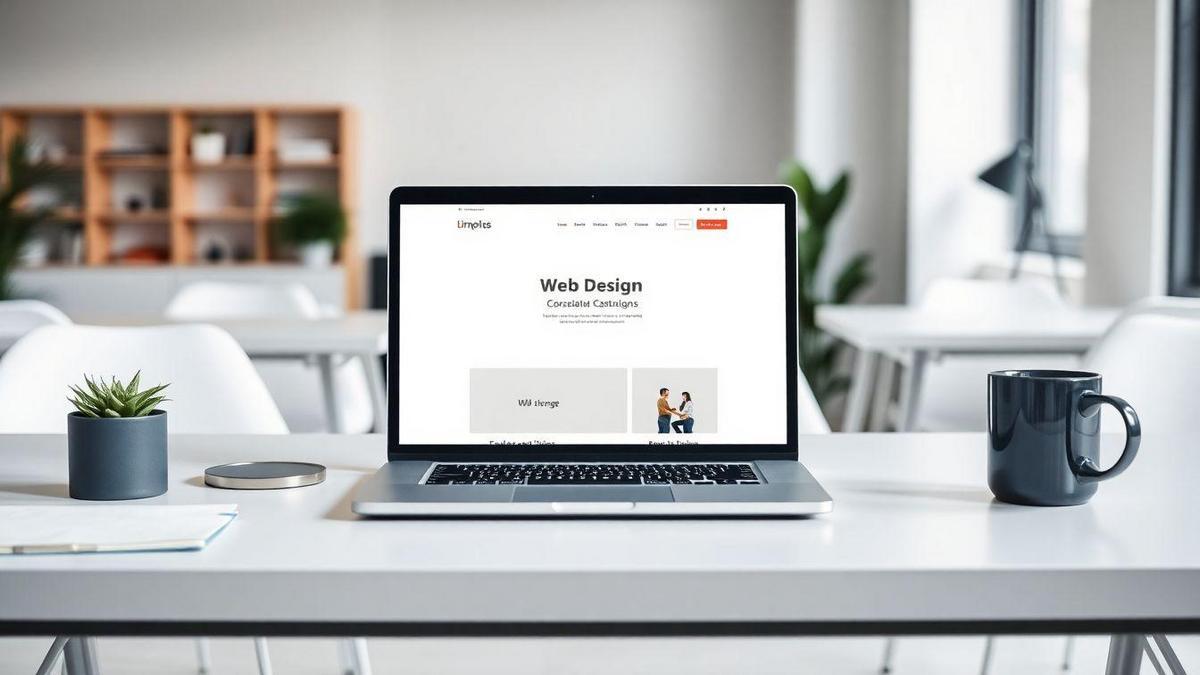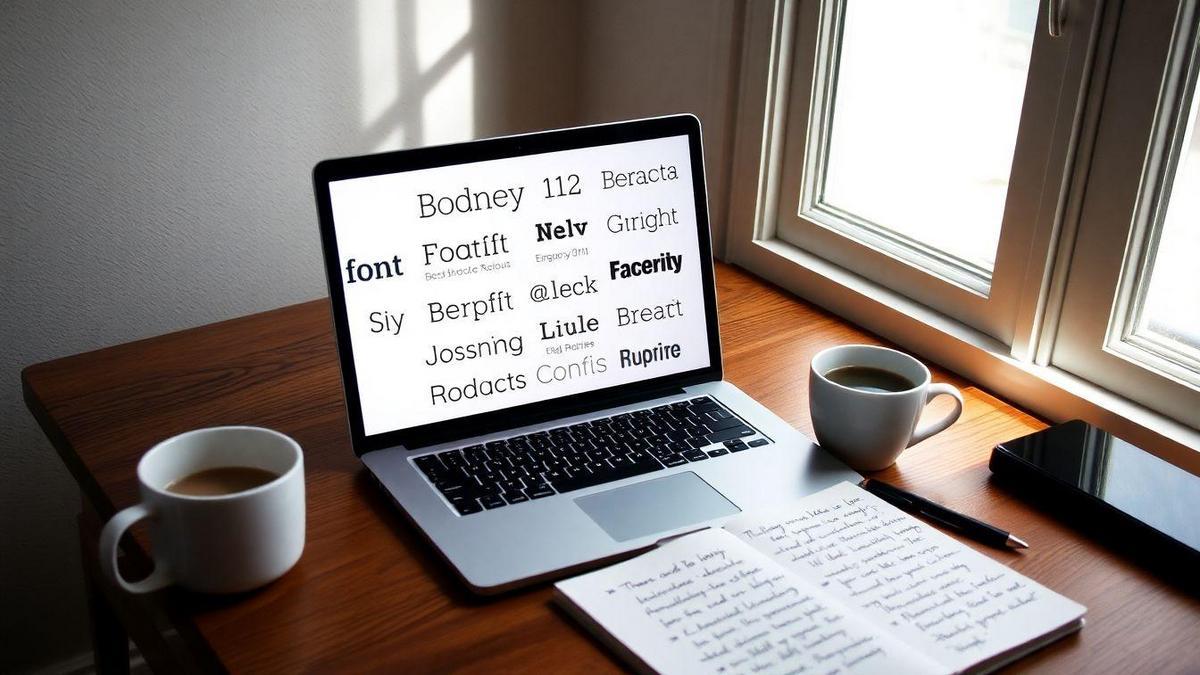Modern and readable fonts for the web can make a big difference in how your visitors feel about your site. When it comes to staying engaged, the right fonts not only look good but also help people read your content easily. In this article, we will explore why readability matters, how to choose the best fonts, and what’s trending in web typography today. Get ready to make your website shine with fonts that draw people in and keep them comfortable!

Why You Need Modern and Readable Fonts for the Web
The Importance of Readability
When you’re browsing the web, readability plays a huge role in whether you stick around or click away. If the text is hard to read, your eyes might glaze over, and you’ll miss out on valuable information. Imagine trying to read a book with tiny, squiggly letters. Frustrating, right? That’s why modern and readable fonts for the web are essential. They make it easy for you to absorb content without straining your eyes.
How Fonts Affect User Experience
Fonts are more than just pretty letters. They can change how you feel about a website. A clean, easy-to-read font can make you feel comfortable and engaged. On the flip side, a messy or overly decorative font can lead you to feel confused or even frustrated. Here’s a quick look at how different fonts can impact your experience:
| Font Type | User Feelings |
|---|---|
| Sans-serif | Modern, clean, and friendly |
| Serif | Traditional, trustworthy |
| Script | Elegant, personal |
| Decorative | Fun, but can be hard to read |
When you choose the right font, you’re not just picking letters; you’re setting the mood for the entire site.
Choosing Fonts for Better Engagement
Selecting the right font can boost engagement. Here are some tips to help you choose wisely:
- Keep it simple: Stick to one or two fonts. Too many choices can be overwhelming.
- Match the tone: Choose fonts that fit the message. For example, a playful font suits a children’s site, while a clean sans-serif works for a tech company.
- Size matters: Make sure your font size is large enough to read easily on all devices.
By focusing on these elements, you can create a web experience that invites users to stay and explore.
Top Modern Web Fonts to Consider
Popular Sans-Serif Fonts for Web
When you think about modern and readable fonts for the web, sans-serif fonts often come to mind. They are clean, simple, and easy on the eyes. Here are some popular choices you might want to consider:
| Font Name | Description |
|---|---|
| Arial | A classic choice, widely used and versatile. |
| Helvetica | Known for its clarity and neutrality. |
| Roboto | A modern font that’s friendly and approachable. |
| Open Sans | Great for web use, it’s legible at any size. |
| Lato | A warm and inviting font, perfect for many sites. |
These fonts are not just easy to read; they also give your website a professional look. You can’t go wrong with any of these options!
Unique Fonts That Stand Out
If you want your website to have its own personality, you might want to explore some unique fonts. These can help your site stand out from the crowd. Here are a few to check out:
- Montserrat: Great for headings, it has a modern vibe.
- Raleway: Elegant and stylish, perfect for a sophisticated feel.
- Poppins: A geometric font that adds a fun twist.
When you choose a unique font, remember that it should still be readable. You want your visitors to enjoy their experience, not struggle to read your content.
Finding the Right Balance Between Style and Readability
In the world of web design, striking a balance between style and readability is key. You want your fonts to look good but also be easy to read. Here are some tips to help you find that sweet spot:
- Limit Font Choices: Stick to 2-3 fonts. This keeps your design clean.
- Check Size and Spacing: Make sure your text isn’t too small. A good size is usually around 16px.
- Contrast Matters: Use contrasting colors for your text and background to make reading easier.
Remember, a stylish font that’s hard to read can drive visitors away. Choose wisely!

The Role of Font Size in Readability
Ideal Font Sizes for Different Devices
When you’re browsing the web, the font size can make a world of difference. On a desktop, a font size of 16px is often the sweet spot. It’s large enough to read comfortably without straining your eyes. But what about when you switch to your mobile device? Here, a font size of 14px to 16px works best. It keeps your text readable while fitting nicely on smaller screens.
Here’s a quick table to help you visualize the ideal font sizes for various devices:
| Device Type | Ideal Font Size |
|---|---|
| Desktop | 16px |
| Tablet | 15px |
| Mobile | 14px – 16px |
How Size Impacts User Comfort
Imagine trying to read a book with tiny text. Frustrating, right? The same goes for websites. If the font size is too small, you might find yourself squinting or zooming in. On the flip side, if the font is too large, it can feel like you’re shouting at your screen.
A well-sized font creates a comfortable reading experience. It helps you stay focused and engaged with the content. Plus, when you’re comfortable, you’re more likely to stick around and explore more.
Adjusting Font Size for Better Accessibility
Accessibility is crucial for a great web experience. If you want your site to be friendly for everyone, consider allowing users to adjust the font size. This feature can be a game-changer.
You can use tools like CSS to make this happen. For example, setting a base font size and then allowing users to increase or decrease it can make your site much more welcoming. Here’s a simple way to do it:
- Set a base font size: Start with 16px.
- Include a button: Add plus and minus buttons for users to adjust the size.
- Use relative units: Consider using em or rem units to make scaling easier.
Making these adjustments can help everyone, especially those with visual impairments, enjoy your content without hassle.
Web Font Trends You Should Know
Current Trends in Web Typography
When it comes to web design, typography plays a huge role. You want your site to be inviting, easy to read, and visually appealing. Here are some trends in web typography you should keep an eye on:
- Variable Fonts: These fonts let you adjust weight, width, and slant all in one file. This means you can get creative without loading multiple font files.
- Bold and Big: Large, bold fonts grab attention. They can make your headlines pop and draw readers in.
- Serif is Back: Once thought outdated, serif fonts are making a comeback. They add a touch of elegance and can be more readable on screens.
- Minimalist Styles: Clean, simple fonts are always in style. They keep things straightforward and easy to digest.
How Trends Influence User Choices
The fonts you choose can sway how users feel about your site. For instance, if you use a modern and readable font for the web, it can create a sense of trust. A study showed that 95% of users say that a website’s design influences their first impression.
| Font Style | User Impression |
|---|---|
| Bold & Modern | Trustworthy |
| Serif | Elegant & Classic |
| Minimalist | Clean & Professional |
If your site looks good, people are more likely to stick around. They may even share it with friends!
Staying Updated with Font Innovations
Fonts are always changing, and staying updated can be a challenge. Here are some tips to keep your font game strong:
- Follow Design Blogs: Websites like Smashing Magazine and A List Apart often discuss new fonts and trends.
- Join Online Communities: Platforms like Behance and Dribbble showcase fresh designs and typography trends.
- Experiment: Don’t be afraid to try new fonts on your projects. Tools like Google Fonts make it easy to test out different styles.

High Readability Fonts for Your Website
Top Choices for Clear Text
When you’re picking fonts for your website, clarity is key. You want your visitors to read your content without straining their eyes. Here are some top choices that stand out:
| Font Name | Style | Why It’s Great |
|---|---|---|
| Arial | Sans-serif | Clean and simple, works everywhere. |
| Verdana | Sans-serif | Wide letters make it easy to read. |
| Georgia | Serif | Classic look that feels friendly. |
| Open Sans | Sans-serif | Modern and very legible. |
| Roboto | Sans-serif | Versatile and popular for web use. |
These fonts are not only modern and readable, but they also fit well in different types of content.
Fonts That Work Well for Long Content
If you’re writing long articles or blog posts, you need fonts that keep readers engaged. Here are some great options for lengthy reads:
| Font Name | Style | Benefits |
|---|---|---|
| Merriweather | Serif | Designed for comfortable reading. |
| Lora | Serif | Stylish and easy on the eyes. |
| PT Serif | Serif | Good for both print and digital. |
| Noto Sans | Sans-serif | Supports multiple languages well. |
| Source Sans Pro | Sans-serif | Clear and professional look. |
These fonts make it easier for your audience to digest long pieces of text. They help keep your readers glued to the page!
Ensuring Your Content is Easy to Read
To make sure your content is easy to read, consider these tips:
- Keep font sizes large enough: Aim for at least 16px.
- Use plenty of white space: It helps break up the text.
- Limit the number of fonts: Stick to two or three to keep things looking neat.
- Contrast is important: Dark text on a light background is usually best.
By following these simple guidelines, you can create a website that’s not just pretty but also easy for everyone to read.
Web-Safe Typography and Its Benefits
What Are Web-Safe Fonts?
Web-safe fonts are typefaces that are widely supported across different browsers and devices. When you use these fonts, you can be confident that your text will look the same no matter where it’s viewed. Some common web-safe fonts include:
- Arial
- Times New Roman
- Verdana
- Georgia
- Courier New
Using these fonts means you won’t have to worry about your text looking wonky or out of place. It’s like having a reliable friend who always shows up on time!
Why They Matter for Your Site
Web-safe fonts matter for your site because they enhance readability and create a seamless experience for your visitors. If your font isn’t supported on a user’s device, it can be replaced with a default font, which might not match your design. This can lead to a disjointed look that turns visitors away.
Ensuring Consistency Across Devices
When you pick web-safe fonts, you’re making sure that your text appears the same on desktops, tablets, and smartphones. This is crucial because people access websites on various devices, and you want them to have the same great experience no matter how they’re browsing.
Here’s a quick table to show the benefits of using web-safe fonts:
| Benefit | Description |
|---|---|
| Readability | Easy to read on all devices. |
| Consistency | Looks the same everywhere. |
| Professional Appearance | Gives a polished look to your site. |
| Faster Loading Times | Simple fonts load quicker than complex ones. |
Choosing modern and readable fonts for the web means your site can shine while keeping it user-friendly.

Clean Web Typefaces for Professional Look
Characteristics of Clean Fonts
When you think about clean fonts, imagine something that’s easy on the eyes. These fonts are usually simple, straightforward, and neat. Here are some key traits:
- Legibility: You can read them without squinting.
- Minimalism: They don’t have extra flourishes or decorations.
- Versatility: They fit well on various backgrounds and designs.
- Professionalism: They give off a polished vibe, making your site look trustworthy.
How Clean Fonts Enhance Design
Using clean fonts can really boost your website’s look. They help create a calm atmosphere that invites visitors to stay longer. Here’s how they work their magic:
- Focus on Content: Clean fonts let your words shine. Visitors spend more time reading, which keeps them engaged.
- Brand Identity: A well-chosen font can reflect your brand’s personality. It tells your story without saying a word.
- User Experience: When text is easy to read, visitors are more likely to return. They appreciate a hassle-free experience.
| Benefit | Description |
|---|---|
| Increased Readability | Visitors can read your content easily. |
| Enhanced Trust | A clean look makes your brand seem reliable. |
| Improved Navigation | Clear text helps users find what they need. |
Choosing Clean Fonts for Your Brand
Picking the right clean font is like finding the perfect pair of shoes; it needs to fit just right. Here are some tips to help you choose:
- Know Your Audience: Think about who will visit your site. What do they like?
- Match Your Style: Your font should reflect your brand’s vibe. Is it fun, serious, or something in between?
- Test It Out: Try a few options and see how they look on your site. Sometimes, what looks good on paper doesn’t translate well online.
In the end, remember that modern and readable fonts for the web can make a world of difference. They’re your silent partners in creating a professional online presence.
Responsive Web Fonts for All Devices
Why Responsiveness is Key
In today’s digital age, responsive web fonts are crucial. Why? Because people access websites on all sorts of devices—phones, tablets, and computers. If your fonts aren’t responsive, they might look great on a desktop but become unreadable on a mobile screen. This can turn visitors away faster than you can say “bounce rate.”
Think about it: when you visit a site, you want to read easily. If the text is too small or squished together, you might just leave. So, ensuring your fonts adapt to different screens is key for keeping your audience engaged.
Adjusting Fonts for Mobile Users
Now, let’s talk about how you can adjust fonts for those mobile users. Here are some tips to keep in mind:
- Use Scalable Units: Instead of fixed sizes, use responsive units like em or rem. This makes sure your text scales well, no matter the device.
- Prioritize Readability: Choose modern and readable fonts for the web. Fonts like Arial, Verdana, or even Google Fonts can make a big difference.
- Test on Different Devices: Always check how your fonts look on various screens. What looks good on a laptop might not work on a smartphone.

User-Friendly Font Choices for Everyone
Fonts That Everyone Can Read
When you’re building your website, choosing the right font is like picking the right outfit for a big event. You want something that looks good and feels comfortable. Fonts like Arial, Verdana, and Georgia are popular because they’re simple and easy to read. They help your visitors get the information they need without straining their eyes.
Here’s a quick look at some modern and readable fonts for the web:
| Font Name | Style | Why It’s Good |
|---|---|---|
| Arial | Sans-serif | Clean and clear |
| Verdana | Sans-serif | Wide spacing, easy to read |
| Georgia | Serif | Classic look, great for text |
| Open Sans | Sans-serif | Friendly and modern |
| Roboto | Sans-serif | Versatile, works well on any device |
Making Your Site Inclusive
Creating an inclusive website means thinking about everyone who might visit. Some people have trouble reading small or fancy fonts. By using clear and straightforward fonts, you make sure that all your visitors feel welcome. It’s like opening the door wide and saying, Come on in!
Think about using larger font sizes and high contrast colors. This way, even those who might struggle a bit can still enjoy your content.
Tips for Selecting User-Friendly Fonts
- Keep it Simple: Stick with basic fonts that are easy to read.
- Size Matters: Use a font size that’s at least 16px to help everyone read comfortably.
- Limit Your Choices: Use no more than two or three different fonts on your site to keep things tidy.
- Test It Out: Check how your fonts look on different devices. What looks good on a computer might not work well on a phone.
By following these tips, you can create a site that’s not just pretty, but also user-friendly for everyone.
Frequently Asked Questions
What are modern and readable fonts for the web?
Modern and readable fonts for the web are fonts that look good and are easy to read on screens. They include popular choices like Arial, Roboto, and Open Sans.
Why are readable fonts important?
Readable fonts help your users understand your content easily. If your text is hard to read, they might leave your site.
Can I use custom fonts on my website?
Yes, you can use custom fonts! Just make sure they’re optimized for the web so they load quickly and look great.
How do I choose a font for my website?
Pick a font that matches your brand and is easy to read. Test it on different devices to make sure it looks good everywhere.
Are there free modern and readable fonts available?
Absolutely! Websites like Google Fonts offer many free modern and readable fonts for the web. You can find great options to use without spending a dime.

Lucas is a technical SEO expert who has optimized over 200 websites and managed Google AdSense and Ad Manager campaigns since 2016. At ReviewWebmaster.com, he shares strategies to boost organic traffic and monetize every single visit.
Types of articles he writes:
-
“How to Increase Your Blog’s RPM with Simple Tweaks”
-
“Technical SEO Checklist for WordPress Sites”
-
“Complete Beginner’s Guide to Google Ad Manager”
Why it works:
Lucas brings a confident, analytical, and performance-driven voice to the site — perfect for readers looking for actionable, results-oriented content.
